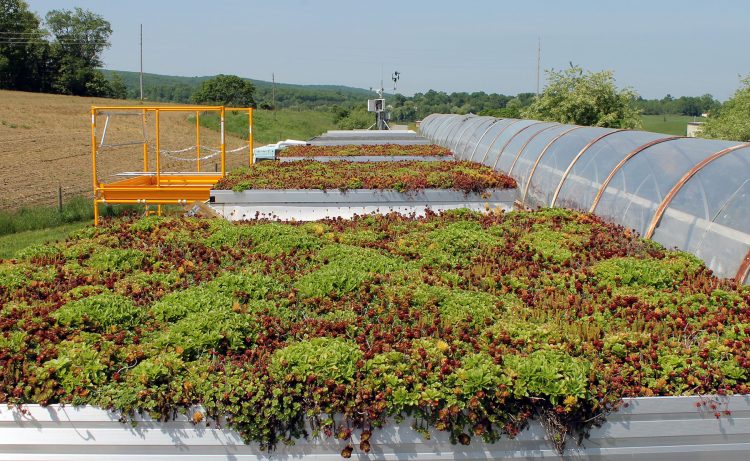Architectural researcher to tell conferees in Germany how 'living roofs' help build better cities

Five platforms at the the Research and Demonstration Facility aat Virginia Tech in Blacksburg, Virginia, were used to test various depths of “green” roofing. The thickest growth is in the foreground, with unplanted growth material and finally reflective roofing material in the distance.
One solution offered by architectural researchers is known as a “green roof” — a roof covered in living, growing plants to soften the effects of heat, flooding, noise, and stormwater runoff.
Elizabeth J. Grant, an assistant professor of architecture and design at Virginia Tech, will present ways for architects to determine the most effective depths of green roofing for stormwater control on Thursday at the International Conference on Building Envelope Systems and Technologies — also known as ICBEST — in Aachen, Germany.
“With growing numbers of people moving into cities, it is crucial to give architects and builders tools to make good decisions about green roofs,” Grant said. “These systems are on the rise not just because they represent a link to the natural world that is scarce in the city, but because they work. Extremes of temperature and rainfall are becoming unpredictable as climates change, and vegetated roofs help us build resilience in a rapidly changing world.”
With Kenneth Black and Jim Jones of the School of Architecture + Design, the team generated equations that can predict the effectiveness of vegetated roof installations to control stormwater runoff relative to temperature, humidity, and frequency of sunlight and rainfall.
Green roofs use the sun to transform water into water vapor, which provides cooling as a byproduct. In the same way, these vegetated roofs reduce stormwater runoff and flow rates, which in turn helps prevent sewers from overflowing and stream banks from eroding.
“Our research should give architects and designers justification that they are helping the environment by incorporating green roofs in their plans,” Grant said. “We are bridging the gap between science and design.”
The researchers built a variety of test platforms with depths of green roofing ranging from about 2.5 inches to 6 inches deep at the Research and Demonstration Facility managed by the College of Architecture and Urban Studies in Blacksburg, Virginia.
Alongside the platforms were a weather station and a rain gauge to measure rainfall, temperature, humidity, wind speed and direction, and solar radiation.
Of 74 rainfall events included in the study, all of the treatment platforms, including the unplanted, growing-medium-only roof, retained significantly more runoff than a white reflective roof membrane with no vegetation or growing medium used for comparison.
Deeper platforms hold more stormwater runoff, but overall green roofs retain about 50 percent of the stormwater compared with about 6 percent for the normal, flat roof.
Light colored roofs or reflective roof surfaces have also been mentioned as solutions to sweltering city temperatures, but recent studies warn that they may merely redistribute heat without reducing it, and they don’t address runoff problems as well as vegetated roofs.
The next step in the research is to analyze the data at five-minute intervals to compare the delays in runoff at the treatment platforms, which is important for understanding sewer-system loads and stream erosion.
Written by John Pastor
Media Contact
More Information:
http://www.vt.eduAll latest news from the category: Architecture and Construction
Newest articles

Sensors for the “charge” of biological cells
A team led by plant biotechnologist Prof Markus Schwarzländer from the University of Münster and biochemist Prof Bruce Morgan from Saarland University has developed new biosensors with which the ratio…

New scan method unveils lung function secrets
A new method of scanning lungs is able to show the effects of treatment on lung function in real time and enable experts to see the functioning of transplanted lungs….

Grapes of math: Quantum breakthrough bears fruit
Grapes show promise for quantum sensing breakthrough. Macquarie University researchers have demonstrated how ordinary supermarket grapes can enhance the performance of quantum sensors, potentially leading to more efficient quantum technologies….



